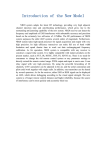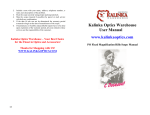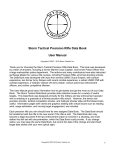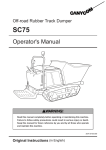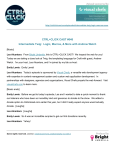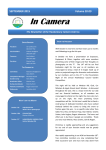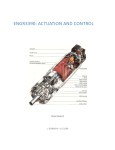Download What are Camera Rangefinders? - Camera Rangefinders for Street
Transcript
Camera Rangefinders for Street Photography If you’ve just discovered photography, then you may have stumbled across rangefinders and instantly fallen in love. The rangefinder is a type of camera that’s named so for the built-in range finding mechanism that will allow the user to measure the distance of a subject, in order to focus a shot more accurately. What are Camera Rangefinders? On a single lens camera, also known as an SLC, the viewfinder is located in the middle of the camera’s body and it works by transmitting the image through the lens, over a mirror and into the viewfinder. So the image you see is the image that will be captured on film. On distance measuring cameras, the viewfinder is placed differently and is offset from the lens. So the image you see in the viewfinder isn’t the exact image that will be captured. This is referred to as a parallax error, which is the difference or displacement in the position of an object that’s viewed along two different lines of sight, and is measured by the semi-angle or angle of the inclination between the two lines. Over a large distance this issue isn’t very noticeable, but at close range it can be fairly obvious. Until you get the hang of using rangefinder cameras you may notice the parallax error when you look at the pictures you’ve taken. The images in your photos may be slightly lower than they looked when gazing through the viewfinder. After a period of time you’ll be able to automatically counter this issue and it will become like second nature for you. Taking photos with rangefinders can be somewhat tricky and they might not be the best choice for individuals who are into macro photography, because the camera will not be directly pointing at the subject during a close-up. Magnification Capabilities for Hi-tech Distance Measuring Cameras Because of the difficulty associated with using rangefinders you’re probably wondering why this type of camera has regained popularity in the last few years. When using this type of camera, you will need to keep your other eye scanning the photo subject and surrounding area. This can give you give your photographs a type of balance that you won’t get if you use an SLC. Most models of distance measuring cameras feature 0.8 X magnification and some models can even go as high as 1.1 X. This type of magnification can give the photographer a better opportunity to frame their shots and can really take a person’s photography to a whole new level. The Major differences between the Single Lens Camera and the Distance Measuring Camera The biggest difference between single lens cameras and rangefinders is the shutter. And most photography enthusiasts believe that this is where the real advantage lies. Many models of distance measuring cameras utilize a shutter made of cloth plane, although there are some models that feature metal shutters. Because there’s no moving mirror, the camera will not experience shutter lag. So while taking photos, your work will have a more fluid feel compared to photos taken using an SLC. If you’re shooting in a crowded public area, then the type of speed that a distance measuring camera can provide, in addition to the quietness of the plan cloth shutter, can make all the difference in the quality of your photos. Rangefinders allow photographers to be as unobtrusive as possible, which is why these cameras are the go-to models for photographers who worked in dangerous locations or situations. It’s also the same type of camera most wildlife photographers use. Another difference between rangefinders and SLC cameras is the lens glass. You won’t enjoy the variety of lenses or mega zooms that you can when you use an SLC. Instead you will mainly use prime lenses that are manual focus. This will also give you the opportunity to try your hand at zone focusing. Zone focusing involves adjusting the camera in order to focus in on a particular zone. This method is widely used among street photographers. Perfecting zone focusing can help you to develop your skills at measuring distance and will make you more aware of the objects around you. The History behind Distance Measuring Cameras These cameras have actually been around since the 1930s, and brought about a new era of photography. For many years people have been drawn in by this type of camera due to its compact design and for its ability to quickly focus a camera lens, without guessing the distance of the subject. The camera’s quick focusing ability and its silent operation led to the creation of photojournalism. A subject can now be photographed in real-time rather than the subject matter staged specifically for the camera. While not recommended for those new to photography, a distance measuring camera can definitely allow you to put your photography skills to the test and will truly allow you to step up your game, giving you the motion and drive to try different photography techniques in a variety of fast-paced settings. Choosing a Laser Rangefinder for Hunting or Photography A laser rangefinder offers a number of different uses and has become a necessary piece of equipment for photography, rifle hunting, bow hunting, golfing and several other activities. Anyone who has had experience using a laser rangefinder knows how easy they are to use and the many benefits they have to offer. This device utilizes an invisible narrow laser that is aimed at an object in order to determine the distance accurately. The beam then reflects off the targeted object, traveling back to the device. The rangefinder will use a high speed clock that determines the time it took for the laser to travel. It then calculates the amount of distance between the target and the device. This process is known as time of flight. The Benefits of using a Laser Rangefinder The distance a laser rangefinder will actually be able to measure may differ from what it says on the product’s box. With most high-end models, the range will be greater than what a cheaper model will be capable of. Rangefinders that can measure super long distances are usually reserved for military use and are able to target an object as far as three miles away. Some military grade models have the ability to determine the distance of targets even further away. Laser rangefinders that are available to the public will not have the same type of impressive range capabilities and can usually target distances up to a thousand yards. But usually this type of range capability is more than what’s needed. While a particular model may say it’s capable of a certain distance it doesn’t mean that you’ll get that the type of distance each time you use it. Maximum distance will depend on a number of factors, including how reflective the object is, the weather conditions and how cluttered the area is. When a manufacturer puts a model’s maximum distance on the box they are using the distance that can be achieved in an ideal situation. On a good day, you’ll be more likely to get seventy-five percent of the maximum range. You’re more likely to run into this type of discrepancy with less expensive models than with higher-end rangefinders. Most expensive models will include superior optics. These rangefinders are more ideal for photography and hunting because they offer improved distance and accuracy. All rangefinders will include some form of magnification. Magnification will usually range between five and eight power. The price of a laser rangefinder will be directly linked to the quality of the product. If you’re using a basic single lens camera instead of a rangefinder camera, then you’ll need to invest in a quality laser rangefinder in order to explore different photography techniques based on range. For rifle hunting, a more affordable rangefinder should work fine. Purchasing a Rangefinder based on use Most models are pretty accurate and will guarantee their accuracy of plus or minus three to six feet. This is usually enough for hunting purposes, but may not be enough for street photography or military use. To find the model that’s right for you, consider the main factors that we have discussed and base your choice on what you intend to use the rangefinder for. For photography or long range shooting you’ll need to consider a more accurate model that can provide a longer distance. For bow or rifle hunting, the standard models should provide you with the right type of accuracy you need. If you need more information on a model you’re interested in, try reading consumer reviews. These reviews can provide you with more detailed information regarding performance and accuracy, and they’re written by people who have had actual experience using these products. Helpful tips for Rangefinder Hunting If you’re serious about hunting then you probably already own a rangefinder hunting device. If you don’t, then you’re missing out on an easier hunting experience. Whether you hunt with a rifle or bow, rangefinder hunting devices include features that will improve your hunting accuracy. Rangefinder Hunting: How to Secure Your Device during a Hunt Many rangefinder hunting models will provide the user with the ability to focus the eyepiece, a feature which wasn’t available a few years ago. Even with perfect eyesight, this type of feature is still very valuable and can have a major impact on your accurate your shots are. Having quick accessibility to your rangefinder is important because a hunt is usually pretty fast-paced. You’ll have a limited amount of time to grab your device and target a kill. Because of this, try wrapping your rangefinder using grip tape or even hockey tape. Hockey tape is somewhat similar to duct tape and remains flexible during colder weather. The wrapping not only helps to improve your grip, allowing for faster access, but it also works to protect the device from the elements or damage that can occur when dropped. If you’re out bow hunting you can attach the rangefinder to a piece of cord around your neck, allowing it to hang at about waist level. This allows you to quickly grab the device without having to take your eyes off the target. However you choose to wear this device, you should put some thought into it before you take it out for a test drive. Be sure to attach or wear the device in a manner that makes it easily accessible and can be put away quickly. You should also be sure to pack an extra battery. After you have used your rangefinder for a while it can be easy to become too reliant on it. You should still practice eyeballing your target and calculating the distance on your own. This helps you to develop your skills as a hunter. You can also use the rangefinder to help train yourself to do this. After eyeballing a shot, use the rangefinder and determine how accurate your guess was. Choosing a Rangefinder for Hunting Deciding on a model to purchase will take some time, unless you have friends that can make some good recommendations. You’ll need to take a look at the optics, distance and accuracy of each model and you’ll also need to learn how it performs for uphill and downhill shots, especially if you bow hunt. Accuracy is extremely critical for the bow hunter and extreme degrees of decline/incline can have a major impact because the distance to the target will be less than on level ground, which in turn lessens the impact gravity has on the arrow. How to Bow Hunt with Rangefinder Binoculars In the art of archery, the ability to judge range plays a major role. An arrow will travel in an arching path and misjudging the range causes more misses than any other factor, including weather and wind. Using rangefinder binoculars has become part of the standard gear used by hunters all across the country. How Rangefinder Binoculars Work Using rangefinder binoculars while bow hunting will definitely improve your chances of landing a shot, but it’s important to learn how to use rangefinder binoculars before you take them on your next hunting trip. While these binoculars are effective and do make all the difference when it comes to accuracy, using them without a proper understanding of how they work can actually hurt your accuracy out in the field. After you have purchased a device, take time to become familiar with how it works. Read the user’s manual and test each mechanism and function by isolating the modes that are specifically designed for bow hunting or rifle use. Other modes include fog and rain modes and the scan mode. The scan mode will give the hunter the running measure of a target in motion, and it can also be used to obtain a viable reading through areas encumbered with vegetation, by panning the device back and forth until the binocular’s laser breaks through. How to Improve Your Rangefinder’s Reading Accuracy This type of rangefinder will work using time of flight technology. The binoculars will send out a laser, capturing its returning reflection, while the device’s microprocessor measures turnaround time, converting it to yardage. If there is an interruption in the laser’s path, it can interfere with this process and will not usually operate as well in thick or cluttered areas. The device will measure the first thing the beam encounters, even if it’s shrubbery or plant life and this will be the reading you receive. In order to work around this issue you will need to anticipate where the animal moves next and quickly adjust the binoculars to a determined landmark before the animal arrives. In areas that feature a number of straight trunked trees, receiving an accurate reading will be simple, even if the ground is covered in vegetation. After you get the hang of using these binoculars you’ll be able to automatically anticipate your target’s every move. There’s a big difference between vertical and straight line compensated range. This is mostly a concern for a bow hunter who is aiming from steep terrain or an elevated area. For steep downhill shots you’ll need to aim for straight line range. Some manufacturers have addressed this issue by creating accurate rangefinder models with built-in tilt compensation, but not every model will include this feature. If you have purchased a standard model, range any tree trunks that are at eye level instead of focusing on the ground your target is standing on. The Best Rangefinder with Pinpoint Accuracy Have you ever wondered how a hunter can take a shot with incredible accuracy or how a photographer can take some amazing distance photos? This type of accuracy will rely on more than just experience and skill. Both types of activities require the use of equipment in order to enhance optical skills that are beyond a person’s limitations. The best rangefinder is a handheld device that can accurately measure the distance between the user and the target. Laser rangefinders have evolved over the years to include a number of extra features. Traditional models which utilize trigonometry are becoming modernized thanks to frequent technological advances. Best Rangefinder Options So exactly why do photographers, golfers and hunters need to rely so heavily on these devices? Using a rangefinder can help a photographer get a clearer distance shot, a golfer land a shot on uneven terrain and the hunter will be able to calculate the exact distance between their bow and the target. Many years ago autofocus was unheard of, so rangefinders were put to work. The older models were much harder to use and not nearly as accurate as the models of today. These past models had to rely heavily on manual calibration. Currently, most models now feature laser technology, which provides faster, more accurate results. These days most models claim that they can reach a range of two to a thousand yards or more. It should be mentioned that a reflective target will make this type of accuracy possible, while a dark target will absorb the light, providing poor results. Three Top Selling Rangefinders The LRF 600 Simmons model is considered one of the best rangefinders for hunting. Featuring a sleek design and black façade, this basic model doesn’t include a ton of bells and whistles and instead focuses on speed and accuracy. With a reputation for performing better than some higher-end models, the LRF is perfect for long range shooting and hunting. This rangefinder is very lightweight, weighing in at just eight ounces, but regardless of its small frame, it’s surprisingly accurate. According to the manufacturer, this device features a range of up to six-hundred yards. The Chuck Adams Edition Bushnell Bow Hunter rangefinder is considered the best rangefinder for bow hunting. Featuring a clean, dark green exterior, this rangefinder weighs in at just over five ounces, making it one of the lightest models on the market. This bow hunter rangefinder features ARC technology for improved accuracy. This technology works by taking into consideration horizontal and vertical factors before reaching a final calculation. The device calculates the distance of the shot depending on the angle, which works to lessen error and increases how accurate your shot is. The RX100i by Leupold allows you to choose from three color options: gray, moss or black. This model features two impressive rangefinder technologies: true ballistic ranging and digitally enhanced accuracy. Both technologies used in a single device means extremely fast results and improved distance accuracy. Readings for true ballistic ranging go up to 25 yards, however, the rangefinder itself can provide readings up to a thousand yards away for targets that are reflective. Top Features for Laser Measuring Device Tools When using a laser measuring device, you’ll be able to achieve a more accurate reading, especially when it comes to extended lengths. The further a measuring tape is extended, the more difficult it will be to get an accurate measurement. Using a laser measuring device means that you don’t have to worry about applying too much tension, which can stretch or break a traditional measuring tape. The many uses for the Laser Measuring Device To use, you’ll need to line up the marks with the starting point. Even the temperature can have an impact on a reading when using a traditional tape measure. The laser measuring device is considered one of the most accurate and fastest ways to obtain a measurement, especially if you have several measurements to take during the course of your day. Most models feature easy operation. Advanced models include more features, so you should choose a model based on what you’re wanting to accomplish. This device projects a laser, similar in appearance to a laser pointer. To use, just point and press the button. The device will automatically measure wherever the laser is pointed. Some models will allow you to select whether you want to include the length of the device itself in the measurement reading. This will come in handy if you’re in a tight spot and need to place the device against a post or wall. Most laser measuring devices can handle basic calculations. They should also be able to store past readings to an internal memory chip. Some laser measuring tools track both maximum and minimum measurements. This allows you to automatically transfer between different units of measure, such as meters and feet. Extra Features for Laser Measuring Tools A favorite feature is the built-in tilt detector, which can take a measurement at an angle. This type of measurement capability can range anywhere from zero to a hundred percent. The Pythagorean function is a versatile feature that’s found on most high-end models. This feature will allow the user to calculate the length of objects using three points. When you use this method you won’t have to be at the beginning or end point when you’re taking a measurement. You can use it if you don’t have a target point, or if you need to determine the height of a window that’s on the second or third floor. Another popular feature is the magnified viewfinder. This feature is helpful if you’re outside and having trouble viewing the laser at a long distance. Bluetooth or cable connections are also optional features. Using Bluetooth technology on your measuring device will allow you to transfer your saved readings and upload them to your computer.









